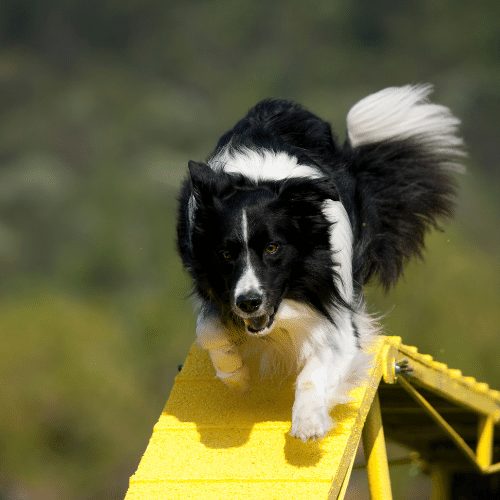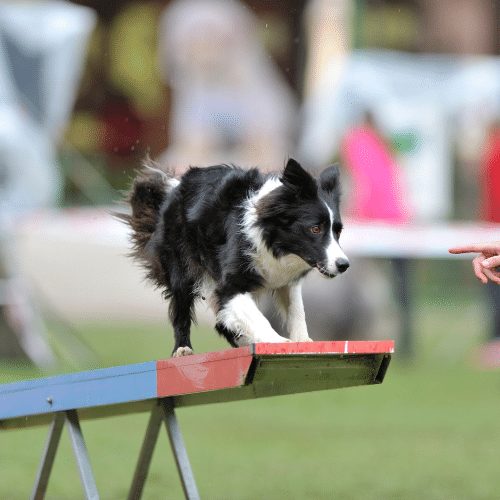Agility
May 30, 2021 2021-06-14 11:19Agility
Agility is a wonderful sport for dogs and their owners. Whether you are just looking to have some fun in your own backyard or striving to attend agility trials and competitions, this activity will make you and your pup smile!
In this agility hub you will find information about every aspect of the sport. From knowing when and how to start over setting up your course to learning about different agility organizations, we have everything about this team sport.
Table of Contents

What is this sport all about?
In dog agility, handler and dog navigate a course consisting of different obstacles. The dog takes the obstacles while the handler runs next to him and directs him on where to go.
Dog agility can be a fun pasttime for dogs and owners – or even be done competitively up to the highest national and international levels.
Dog agility training consists of teaching the dog to navigate the obstacles as well as to listen to the handler’s directions. It takes focus, athletic ability and a tight bond between owner and dog to do well on an agility course.

What a course looks like
A typical agility course consists of:
- Jumps of different kinds
- Tunnels
- Weave poles
- Contact obstacles (dogwalk, A-frame, teeter and table)
Courses come in different levels of difficulty, from very easy to extremely difficult. Owner and dog teams will choose the level of course they run based on their skills and training experience.
Getting started with training
If you want to get your feet wet and see if dog agility is the right sport for you and your pup, you can easily start out at a local class or even at home with an online course.
With just a little bit of space and a few jumps you can set up a lot of different sequences and courses.
The obstacles are typically taught in order of difficulty, starting with the easiest ones and progressing to the hardest.
A typical training progression might be:
1. Jumps and tunnels
Jumps and tunnels are easily taught by putting a reward the dog likes on the other side of the obstacle. For example you can put a toy or a piece of cheese on one side of a hurdle, hold your dog on the other side and then release him to the reward. That way he is successful right from the start.
The same approach is used for tunnels. Hold the dog on one side of the tunnel and then have a helper hold a treat into the other end. You can happily call the dog’s name and praise him as he runs through, then give him his treat.
2. Dogwalk and table
The dogwalk and table are the two easier contact obstacles. On the pause table, dogs stay for a count of 5 seconds and then move on. The dogwalk is navigated by walking across. Some dogs may be hesitant at first, being patient and generous with treats is the best way to build up their confidence.
3. A-frame and teeter
The A-frame and teeter are more difficult contact obstacles. They require the dog to have some momentum to navigate successfully.
The A-Frame is a tall and steep. If dogs are slow and not confident, they will not make it across. One way to build their confidence is to lower the A-Frame and teach them to run over it quickly with thrown toys are treats.
The teeter totter (also called an agility seesaw) can be the scariest obstacle for dogs. The tipping point is unpredictable for them and the slower they are, the more unpredictable it gets!
Ideally dogs should be taught to run very quickly across the teeter and stop at the very end. That way, they learn that the teeter will only tip once they reached the contact zone. That makes it much more predictable for them and they will feel safer.

4. Weave poles
Last but not least, the weave poles often are the most difficult obstacle for dogs to learn. Weaving in and out of 12 poles is a skill that is hard to teach for owners – and difficult to understand for the dog. By using techniques such as the channel method this can be made easier for the dog.
History of dog agility
Dog agility is a very new sport. It was created in 1977 in England and saw its first public performance in 1978 at the Crufts Dog Show. The sport quickly became popular and spread outside of the UK as well.
In 1986, USDAA (United Stated Dog Agility Association) was founded and soon joined by other agility clubs such as the agility section of the American Kennel Club, NADAC, and later UKI and others.
The original agility course looked quite different from today’s courses. While it contained the most common obstacles such as weave poles, jumps and tunnels, the setup and makeup of the obstacles did not look like today’s courses.
Over the years, obstacles were changed and at times removed (such as the collapsible tunnel, which is no longer part of any agility courses).
Agility for fun
While some owners strive to attend competitions with their dogs, many participate in agility for fun only. You can set up a couple jumps in your backyard and work there with your dog without ever competing in any shows. Agility is beneficial for all healthy, adult dogs. It helps them get rid of excess energy, practice focus and attention skills and last but not least bond with their handler.
Agility competitions
If your dog is especially fast and agile, you may want to take him to an agility competition. The best way to prepare is to visit a local show and watch the runs. This will give you an idea of the requirements for your dog’s skills, as well as your own handling.
For many owners, it is intimidating to enter their first competitions. Do not be afraid – everyone started at some point and most handlers will be happy to help you with any questions or concerns you have along the way.
If you are striving to enter competitions, keep in mind that it usually takes at least one year of agility training for dogs to be able to run competition courses. Do not enter your dog before he is ready, or it will not be a good experience for him!
Agility articles
Below you can find detailed articles on any aspect of dog agility. Make sure to check out our online agility course as well!

